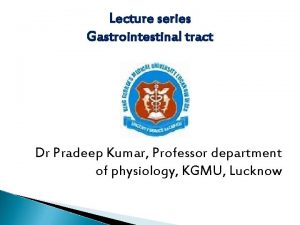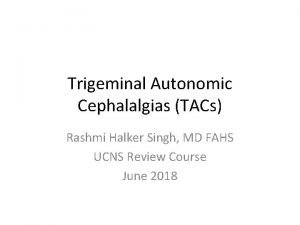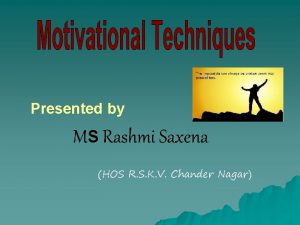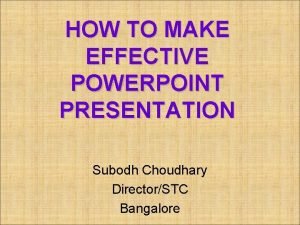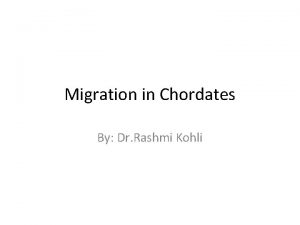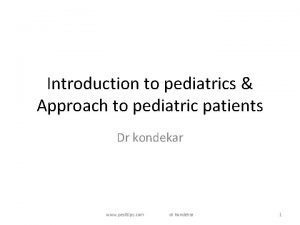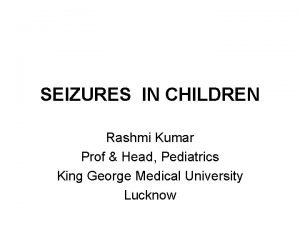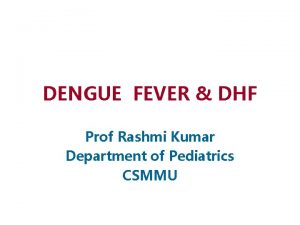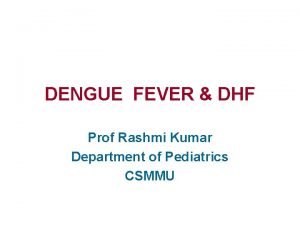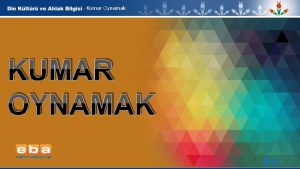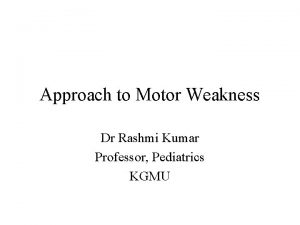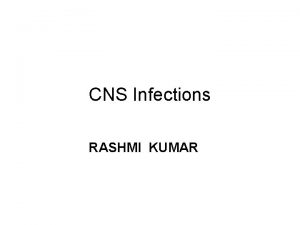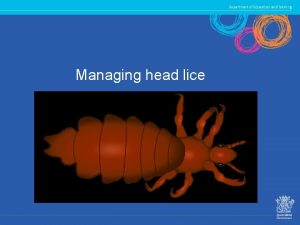Introduction to Pediatrics Rashmi Kumar Prof Head Pediatrics















- Slides: 15

Introduction to Pediatrics Rashmi Kumar Prof & Head, Pediatrics CSMMU

Pediatrics • Earlier treated as small adults, but unique problems, definitive approach • Treating children 0 -21 yrs/ 18 yrs/14 yrs/ 12 yrs • Human child vs animals • Population pyramid • Population of India? • 42% of population is below 18 yrs

What’s different? • Treating children (birth to 21 yrs); – Growing / developing individuals • Need to remember doses/ intakes by weight/size • Diseases of children affect G&D disorders of G&D as a symptom • Primary disorders of G&D – Child’s metabolism is different (faster) • • Drug doses are higher Fluid/ calorie intake higher Parameters (HR, RR higher, BP lower in younger) Higher proportion of body water

What’s different? • Spectrum of disease in children is different – Congenital/inherited – Infectious – Nutritional – Less of degenerative – atherosclerosis/ CAD/ HT – Less psychiatric – Still, overlap with adult medicine is there

What’s different? • Child’s response to disease and treatment is different: – Deteriorate very quickly – need careful watching – Improve also very quickly – gratifying – Hold more true for younger kids

Pediatric History • Taken 2 nd hand, from caregiver • Some symptoms maybe nonspecific – eg crying, vomiting, diarrhea • Sequence • 4 extra histories – Feeding – Antenatal, neonatal – Developmental – Immunization

Pediatric examination • Rapport important • Do not follow set sequence, leave unpleasant parts to the end • Some signs are different in children – eg palpable liver, brisk tendon reflexes, extensor plantar • Sometimes, just not possible – eg neurological, percussion, auscultation, JVP, AF • Abdominal palpation easier • ENT examn • Nonspecific signs in younger kids

Approach • Lower threshold for investigation • Lower threshold for treatment • Remember, uncommon presentation of a common ailment is more likely than a rare disease • Make a list of possibilities, with points for and against Procedures • Generally easier, except in the very tiny • Drips difficult • Sedation, analgesia

Examination • Major subject in Part II MBBS • Separate subject since 1997, need to pass separately • Internal assessment • One theory paper • Practical – long case, short case, newborn, viva, OSCE

Some definitions • Embryogenesis: 1 st eight weeks after fertilization • Fetal period: the stage between the third and ninth months of in utero human development, during which there is growth of preformed structures • Perinatal period: 22 completed weeks (154 days) of gestation (the time when birthweight is normally 500 grams) and ends seven completed days after birth'. • • • Newborn 0 -1 month Infant birth to 1 year Toddler 1 -3 years Child - primary school, middle and high Adolescent 10 -21 yrs

Stats LBW 28% Underweight 43% Stunted 48% One third of all malnourished children live in India – malnutrition capital • Contributory cause for child mortality • •

Stats • IMR 47. 5/1000 • Under 5 mortality 62. 7/1000 • Neonatal mortality rate 32/1000 – accounts for 2/3 rd of IMR and ½ of under 5 mortality • 90% of all deaths are easily preventable – Neonatal causes – sepsis/pneumonia, LBW, birth asphyxia – ARI – Diarrhea

Child Survival Strategies • • • Early breast feeds Exclusive breast feeds Appropriate weaning Vaccination Antenatal, intrapartum and neonatal care Case management of pneumonia and diarrhea

Careers in Pediatrics • Very vast, varied • Tough • Satisfying – incorporates the Art and Science of medical practice • Ambulatory, indoor, emergency, intensive care • Subspecialties – neonatology, neurology, PHO • Research • Community/ public health

• Even a lifetime is not enough to master even one specialty • If the quest continues, you will enjoy the journey • Remember, you always learn something new from each patient, however mundane you think his problem is
 Cholegogue
Cholegogue Paroxysmal hemicrania
Paroxysmal hemicrania Dr rashmi saxena
Dr rashmi saxena Rashmi choudhary presenter
Rashmi choudhary presenter Dr rashmi choudhary
Dr rashmi choudhary Rashmi kohli
Rashmi kohli Dr rashmi malhotra
Dr rashmi malhotra Dhuryodhana
Dhuryodhana Introduction to pediatrics
Introduction to pediatrics Dividing head uses
Dividing head uses The attacking firm goes head-to-head with its competitor.
The attacking firm goes head-to-head with its competitor. The head of moving head disk
The head of moving head disk Parts of the neck
Parts of the neck Tonic syllable
Tonic syllable Suction lift
Suction lift
